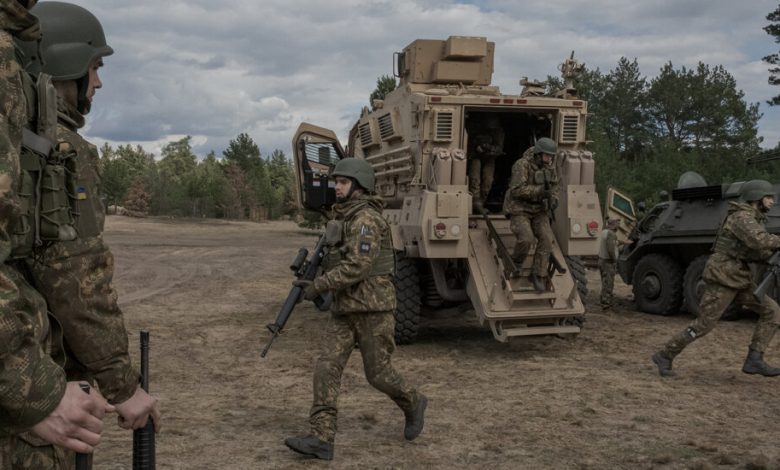U.S. Aid to Ukraine, and When It Might Run Out, Explained

Billions of dollars in U.S. military and economic aid have enabled Ukraine to fend off Russia’s invasion, but the future of that support is now in serious doubt.
Congress approved a stopgap deal last month to keep the federal government open, but it excluded a request from President Biden to give Ukraine another round of funding. As the House of Representatives decides who will be its next speaker, some Republicans are digging in against sending more money to Kyiv.
Mr. Biden has said for months that the United States will support Ukraine’s fight against Russia “for as long as it takes.” But he cannot make that guarantee because congressional approval is required for future infusions of aid.
Administration officials warn that the aid is critical to Ukraine’s survival, and they say they are studying options should Congress halt or reduce U.S. support for the country.
How much has the United States given to Ukraine so far?
Congress has approved about $113 billion in response to Russia’s full-scale invasion in February 2022.
Nearly $62 billion of that has gone to the Defense Department. Another $32.5 billion has been allocated to the U.S. Agency for International Development.
Most of the rest has been funneled to the State Department, along with other departments and agencies, according to the Center for Strategic and International Studies.
Not all of the money has been spent directly on Ukraine. Some of it has helped fortify other European countries against further Russian military aggression, political interference and disinformation campaigns.
And some has gone to meet higher expenses in the Defense Department for things like new U.S. troop deployments to Europe.
What happens if Congress does not approve more money for Ukraine?
Militarily, Ukraine has some breathing space: Under previous spending bills passed by Congress, Mr. Biden can still draw about $5.6 billion in matériel from the military’s reserves (mostly thanks to a Pentagon accounting error that overvalued aid that has already gone to Ukraine).
For context, a $500 million drawdown in June was enough to fund Bradley and Stryker vehicles, air defense munitions, artillery, multiple launch rocket systems, anti-tank weapons, anti-radiation missiles and precision aerial munitions, according to the State Department.
And a pause in new funding does not affect existing Pentagon contracts under the Ukraine Security Assistance Initiative. That means new weapons and equipment will continue to be shipped to Ukraine in the coming months and years.
As of May, the Defense Department reported that $5.6 billion had been contracted to produce items for Ukraine such as HIMARS missiles, tactical vehicles, radar, ammunition and many others.
“Congress’s inability to fund a new package right now doesn’t immediately turn off the spigot to Ukraine because many billions of defense aid is already in train for medium- and longer-term contracts,” said Eric Ciaramella, a former National Security Council director for Ukraine who is now a senior fellow at the Carnegie Endowment for International Peace. “And so even in a scenario where Congress is unable to fund a new package, U.S. defense support for Ukraine will continue.”
Economic and humanitarian aid might be a greater worry. It is unclear whether the Biden administration has any remaining funds to tap to support Ukraine’s federal budget and to meet the needs of the country’s millions of refugees. The U.S. Agency for International Development did not respond to a request for comment.
U.S. and European officials say Europe could make up some slack, particularly for economic and humanitarian needs, if American aid dries up entirely.
But Europe would be hard-pressed to match the United States’ ability to produce large amounts of armaments quickly.
“We can’t make it without a strong American commitment,” Anders Fogh Rasmussen, a former NATO secretary general, said in an interview last week.
How might President Biden secure more aid from Congress?
That is a question administration officials have been debating in recent days. Mr. Biden could ask for more modest, incremental spending measures that might be easier for Congress to swallow. Or, to avoid recurring political battles, he might choose to go all-in for a much larger aid package that could carry Ukraine for many months, potentially even through the 2024 U.S. presidential election.
The path forward partly depends on how House Republicans resolve the political infighting that led to the ouster of Kevin McCarthy as speaker on Tuesday. Some of the Republicans who toppled Mr. McCarthy called him too supportive of Ukraine spending. And at least one prominent candidate to replace him, Representative Jim Jordan, Republican of Ohio, has said that as speaker he would not bring a Ukraine funding bill to the House floor.
It is possible that Mr. Biden could persuade the likes of Mr. Jordan to act by making political concessions of his own, for instance by meeting some Republican demands for tougher action to limit undocumented migration across the U.S.-Mexico border. The Senate is generally more supportive of spending to defend Ukraine.
How has the money for Ukraine been spent so far?
Congress has given the Biden administration considerable flexibility in when and how it can spend the $113 billion that has been allocated.
The United States has spent nearly $44 billion on military aid for Ukraine, according to the State Department.
Mr. Biden has used a power known as the Presidential Drawdown Authority dozens of times to quickly ship weapons to Ukraine. That allows the Pentagon to send artillery shells, armored vehicles, missiles and other equipment from the U.S. military’s stockpiles. The Pentagon then contracts with domestic arms manufacturers to restock its supplies, using the money allocated by Congress.
The Defense Department has also issued contracts for manufacturing new arms and ammunition earmarked for Ukraine under the Ukraine Security Assistance Initiative.
The United States has sent huge sums to keep Ukraine’s government afloat amid the economic disruption caused by the Russian invasion. The U.S. Agency for International Development has spent more than $13 billion on so-called direct budget support for Ukraine. That money, channeled through the World Bank, has enabled Kyiv to fund things like pensions, schools and other basic services during the economic stress of wartime.
Why is there a political fight over the aid now?
Public support for Ukraine spending has been eroding over time. A CNN poll in August found that a majority of Americans opposed sending any more aid to the country.
Ukraine’s surprisingly valorous defense against Russia and subsequent evidence of Russian war atrocities significantly rallied American public opinion to Kyiv’s side. But after 20 months, the war appears to be settling into a grinding stalemate.
Several Republican presidential candidates — including former President Donald J. Trump — are insisting that money for Ukraine would be better spent on domestic priorities like border control.
Arguments about U.S. spending priorities around the budget deal in Congress last week brought the issue to a head.
Eric Schmitt contributed reporting.




